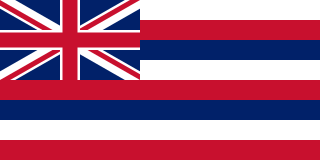
The Republic of Hawaiʻi was a short-lived one-party state in Hawaiʻi between July 4, 1894, when the Provisional Government of Hawaii had ended, and August 12, 1898, when it became annexed by the United States as an organized incorporated territory of the United States. In 1893 the Committee of Public Safety overthrew Kingdom of Hawaii Queen Liliʻuokalani after she rejected the 1887 Bayonet Constitution. The Committee of Public Safety intended for Hawaii to be annexed by the United States but President Grover Cleveland, a Democrat opposed to imperialism, refused. A new constitution was subsequently written while Hawaii was being prepared for annexation.
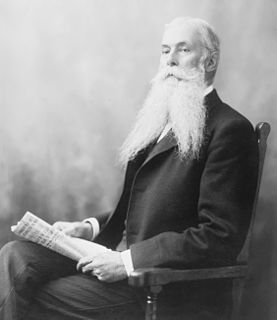
Sanford Ballard Dole was a lawyer and jurist from the Hawaiian Islands. He lived through the periods when Hawaii was a kingdom, protectorate, republic, and territory. A descendant of the American missionary community to Hawaii, Dole advocated the westernization of Hawaiian government and culture. After the overthrow of the monarchy, he served as the President of the Republic of Hawaii until his government secured Hawaii's annexation by the United States.
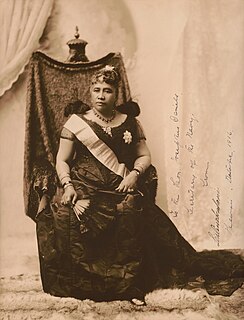
Liliʻuokalani was the only queen regnant and the last sovereign monarch of the Hawaiian Kingdom, ruling from January 29, 1891, until the overthrow of the Hawaiian Kingdom on January 17, 1893. The composer of "Aloha ʻOe" and numerous other works, she wrote her autobiography Hawaiʻi's Story by Hawaiʻi's Queen during her imprisonment following the overthrow.
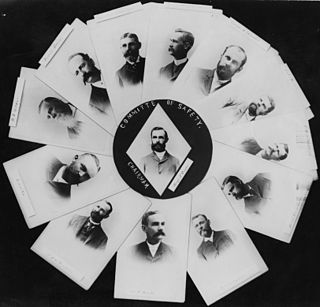
The Committee of Safety, formally the Citizen's Committee of Public Safety, was a 13-member group of the Annexation Club. The group was composed of mostly Hawaiian subjects of American descent and American citizens who were members of the Missionary Party, as well as some foreign residents in the Kingdom of Hawaiʻi. The group planned and carried out the overthrow of the Kingdom of Hawaiʻi on January 17, 1893. The goal of this group was to achieve annexation of Hawaiʻi by the United States. The new independent Republic of Hawaiʻi government was thwarted in this goal by the administration of President Grover Cleveland, and it was not until 1898 that the United States Congress approved a joint resolution of annexation creating the U.S. Territory of Hawaiʻi.

Lorrin Andrews Thurston was an American lawyer, politician, and businessman born and raised in the Kingdom of Hawaiʻi. Thurston played a prominent role in the Overthrow of the Hawaiian Kingdom that replaced Queen Liliʻuokalani with the Republic of Hawaii, dominated by American interests. He published the Pacific Commercial Advertiser, and owned other enterprises. From 1906 to 1916 he and his network lobbied with national politicians to create a National Park to preserve the Hawaiian Volcanoes.

Robert William Kalanihiapo Wilcox, nicknamed the Iron Duke of Hawaiʻi, was a Native Hawaiian whose father was an American and whose mother was Hawaiian. A revolutionary soldier and politician, he led uprisings against both the government of the Hawaiian Kingdom under King Kalākaua and the Republic of Hawaii under Sanford Dole, what are now known as the Wilcox rebellions. He was later elected the first delegate to the United States Congress for the Territory of Hawaii.
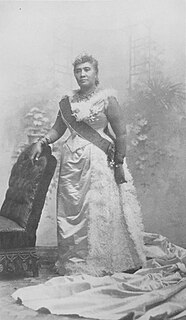
The proposed 1893 Constitution of the Hawaiian Kingdom would have been a replacement of the Constitution of 1887, primarily based on the Constitution of 1864 put forth by Queen Lili'uokalani. While it never became anything more than a draft, the constitution had a profound impact on Hawaiʻi's history: it set off a chain of events that eventually resulted in the overthrow of the Hawaiian Kingdom.

The 1887 Constitution of the Hawaiian Kingdom was a legal document prepared by anti-monarchists to strip the Hawaiian monarchy of much of its authority, initiating a transfer of power to American, European and native Hawaiian elites. It became known as the Bayonet Constitution for the use of intimidation by the armed militia which forced King Kalākaua to sign it or be deposed.

The overthrow of the Hawaiian Kingdom began on January 16, 1893, with a coup d'état against Queen Liliʻuokalani on the island of Oahu led by the Committee of Safety, composed of seven foreign residents and six non-aboriginal Hawaiian Kingdom subjects of American descent in Honolulu. The Committee prevailed upon American minister John L. Stevens to call in the U.S. Marines to protect the national interest of the United States of America. The insurgents established the Republic of Hawaii, but their ultimate goal was the annexation of the islands to the United States, which occurred in 1898.

The Wilcox rebellion of 1889 was a revolt led by Robert Wilcox to force King Kalākaua of Hawaii to reenact the Hawaiian Constitution of 1864 from the Constitution of 1887.

The Hawaiian Kingdom, or Kingdom of Hawaii, was a sovereign state located in the Hawaiian Islands. The country was formed in 1795, when the warrior chief Kamehameha the Great, of the independent island of Hawaii, conquered the independent islands of Oʻahu, Maui, Molokaʻi and Lānaʻi and unified them under one government. In 1810, the whole Hawaiian archipelago became unified when Kauaʻi and Niʻihau joined the Hawaiian Kingdom voluntarily. Two major dynastic families ruled the kingdom: the House of Kamehameha and the House of Kalākaua.

The Hawaiian rebellions and revolutions took place in Hawaii between 1887 and 1895. Until annexation in 1898, Hawaii was an independent sovereign state, recognized by the United States, United Kingdom, France and Germany with exchange of ambassadors. However, there were several challenges to the reigning governments of the Kingdom and Republic of Hawaii during the 8+1⁄2-year (1887–1895) period.

Charles Burnett "C.B." Wilson was a British and Tahitian superintendent of the water works, fire chief under King Kalākaua, and Marshal of the Kingdom under Queen Liliʻuokalani. Wilson was also the father of John H. Wilson.

Luther Aholo was a politician who served many political posts in the Kingdom of Hawaii. He served multiple terms as a legislator from Maui and Minister of the Interior from 1886 to 1887. Considered one of the leading Hawaiian politicians of his generation, his skills as an orator were compared to those of the Ancient Greek statesman Solon.

The 1892 Session of the Legislature of the Hawaiian Kingdom, also known as the Longest Legislature, was a period from May 28, 1892, to January 14, 1893, in which the legislative assembly of the Hawaiian Kingdom met for its traditional bi-annual session. This unicameral body was composed of the upper House of Nobles and the lower House of Representatives. This would be the first session during the reign of Queen Liliʻuokalani and the last meeting of the legislative assembly during the Hawaiian monarchy. Three days after the prorogation of the assembly, many of the political tension developed during the legislative debates and the queen's attempt to promulgate a new constitution while her legislators were not in session led to the overthrow of the Hawaiian Kingdom on January 17, 1893.
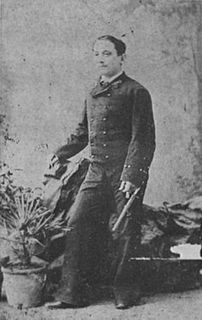
Robert Napuʻuako Boyd was a Native Hawaiian insurgent leader during the latter years of the Kingdom of Hawaii. Educated under the government-funded study program of King Kalākaua, he attended the Royal Naval Academy at Livorno in Italy. He became a friend of Robert William Wilcox, another Hawaiian student enrolled at Turin. They were both recalled back in Hawaii after the government stopped funding their education. Back home, he participated with Wilcox in the unsuccessful Wilcox rebellion of 1889 aimed at restoring political power to the king.
The Hui Kālaiʻāina was a political group founded in 1888 to oppose the 1887 Constitution of the Hawaiian Kingdom, often known as the Bayonet Constitution, and to promote Native Hawaiian leadership in the government. It and the two organizations of Hui Aloha ʻĀina were active in the opposition to the overthrow of the Hawaiian Kingdom and the annexation of Hawaii to the United States from 1893 to 1898.

Charles F. Creighton (1862–1907) was a member of Queen Liliʻuokalani's Cabinet Ministers as Attorney General of the Kingdom of Hawaii for the period November 1–8, 1892. Following the Overthrow of the Hawaiian Kingdom, he was arrested for his involvement in the 1895 Wilcox rebellion attempt to restore the monarchy. He accepted temporary exile to the United States to avoid a lengthy incarceration. His father Robert James Creighton had served as Kalākaua's Minister of Foreign Affairs.

Samuel Nowlein was a Native Hawaiian Colonel who was a monarchist and known for organizing the 1895 Wilcox rebellion against the Republic of Hawaii before being caught and arrested during the rebellion.



















